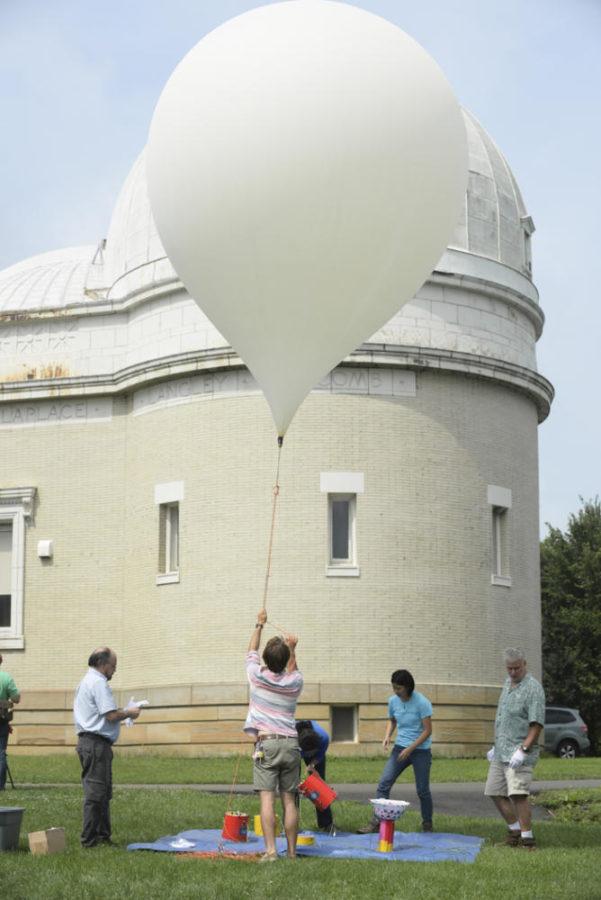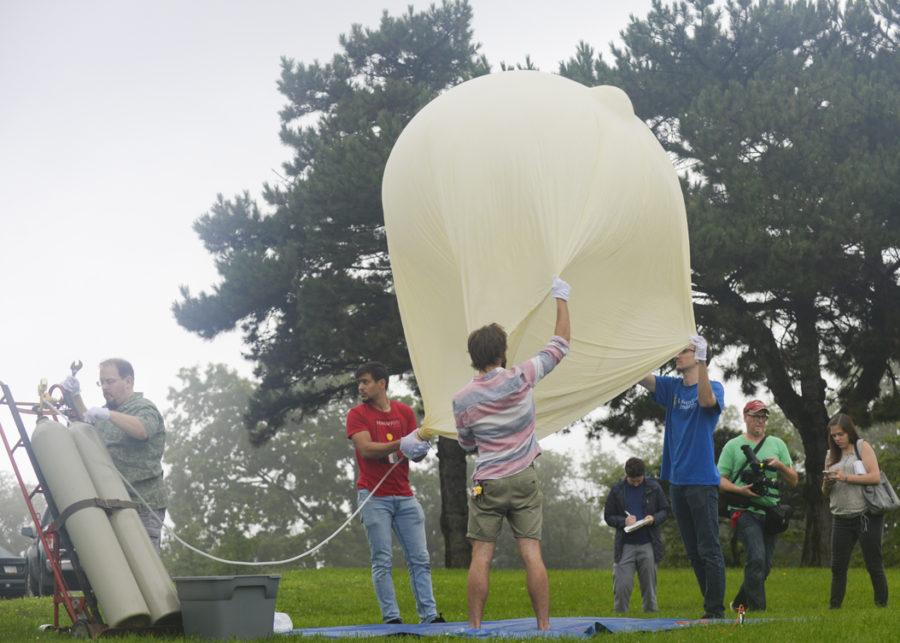After an intense downpour the morning of the test launch, the dark clouds parted, uncovering a bright blue sky just in time for the Pitt Shadow Bandits to release their research balloon to float up to the top of the earth’s atmosphere.
The Pitt Shadow Bandits — a team of Pitt students, faculty and staff — held a high-altitude balloon test launch on Friday to serve as practice for the Aug. 21 total solar eclipse. The team will be traveling to Springfield, Tennessee, to launch a research payload as part of NASA’s Eclipse Ballooning Project, alongside nearly 60 other teams across the nation.
The last total solar eclipse that could be viewed from the U.S. was in 1979, and the last one that was visible coast to coast — like the one in August will be — was in 1918. So this is the first opportunity to livestream a total solar eclipse — broadcasting it to viewers not lucky enough to be in the total eclipse path. Pittsburgh will only see a partial eclipse — hence why the team is traveling to Tennessee.
The team launched the test balloon at 11:20 a.m. Friday at the Allegheny Observatory after a few hours of set up. The team is researching shadow bands — rapidly flickering waves of light that can be seen on plain-colored surfaces before and after a total solar eclipse. Their goal is to either confirm or disprove the standing theory that shadow bands are caused by atmospheric turbulence.
Dr. Dave Turnshek, the director of the Allegheny Observatory and a professor in Pitt’s Physics and Astronomy Department, said that if they find shadow bands above the earth’s atmosphere, then the theory is wrong because above the earth’s atmosphere is not subject to atmospheric turbulence.
“I reviewed the theory and so on and I say, you know, it’s probably right but it’s not 100 percent convincing,” Turnshek said. “So we decided that what we were going to do is search for shadow bands above the earth’s atmosphere.”

The Shadow Bandits’ balloon will be carrying a 12 pound payload equipped with a GPS iridium satellite, microcomputers, streaming video and still cameras, temperature sensors and photo-diodes — arrays of sensitive light detectors. The team will monitor identical photo-iodides on the ground and in the air during the syzygy — when three celestial bodies align — in order to sense the variations in light levels for the shadow bands.
The balloon takes about 1.5 hours to rise to an altitude of between 85,000 and 105,000 feet — reaching the edge of the earth’s atmosphere — before the payload parachutes down to earth, often taking up to 30 minutes. The Shadow Bandits recovered the balloon’s payload from a farm near Saltsburg — about 35 miles east of Pittsburgh — at 2 p.m. on Friday, approximately two hours after the launch.
The cameras on the payload will stream live video of the eclipse from the balloon. Along with video from other participating teams, this will provide the first-ever opportunity to view a total solar eclipse live from near-space as the path of totality moves across North America.
And with all of the sensors and cameras on the payload, the project requires a lot of designing and technical skills. So according to Dr. Sandhya Rao, a professor in the Department of Physics and Astronomy, the team is primarily made up of engineering and physics majors.
“They put out a call for students who wanted to work on this project,” Rao said. “NASA basically gave funds to support undergrads who want to work on this.”
Marshall Hartman, who graduated this past spring as a mechanical engineering major, said there was an application process to become part of the team, but that professors were already interested in him joining.
Hartman said that it took him a while to catch up with the programming that the project requires, but once he did, there were other factors to worry about. Hartman said that most of the issues are out of their control, like weather and issues with the website stream.
“There’s always some unexpected barriers that we run into, but that’s been part of why I like this project, too, because it’s all about facing new problems and trying to figure out how to solve them,” Hartman said.
In addition to the technical problems, Turnshek has additional concerns surrounding the Tennessee trip.
“Lots of things could go wrong in Tennessee. For example, we might not be able to get food and the students could go hungry,” Turnshek said jokingly. “But seriously, we have to worry about having access to helium down there, to fill the balloon.”
The team went to Tennessee on a scouting trip to arrange getting helium there instead of in Pittsburgh. But Turnshek said the team is still debating whether or not it’d be more assuring to bring it from Pittsburgh, the only issue being that it would require renting a trailer.
Whatever happens, the team is sure they will find helium for their balloon and food for themselves down in Springfield. But because all of the directors of the observatory will be in Tennessee, the Pittsburgh residents who stay behind and want to see the eclipse from the Allegheny Observatory are out of luck.

People who opt to stay in Pennsylvania will only see a partial solar eclipse that will begin at 1:10 p.m., reach its maximum — covering 81 percent of the sun — at 2:35 p.m. and will end at 3:55 p.m. NASA strongly suggests wearing eclipse glasses when viewing the rare — and blinding — astronomical event.
“This is an opportunity of a lifetime,” Rao said. “Just be aware that this thing is happening.”
The last opportunity to view a total solar eclipse from the U.S. was back in 1979, when Jimmy Carter was president, a gallon of gas was only 89 cents and Gloria Gaynor had just released her hit single “I Will Survive.”
According to Rao, Turnshek’s father took him and his friend to see the 1979 total solar eclipse at Virginia Beach.
“[Turnshek] was in ninth grade and his dad took him and a friend. That friend is actually going to be with us in Tennessee,” Rao said.
Turnshek took photographs of the last total solar eclipse seen in the U.S., and this upcoming eclipse is the first big opportunity since.
“None of us are eclipse chasers,” Turnshek said. “But when there’s an eclipse in the U.S., we’re gonna take advantage of it.”


